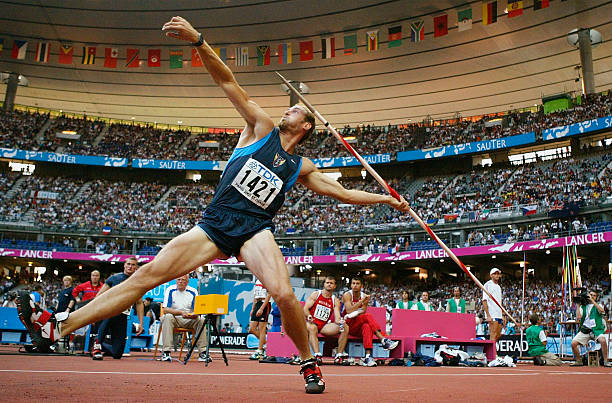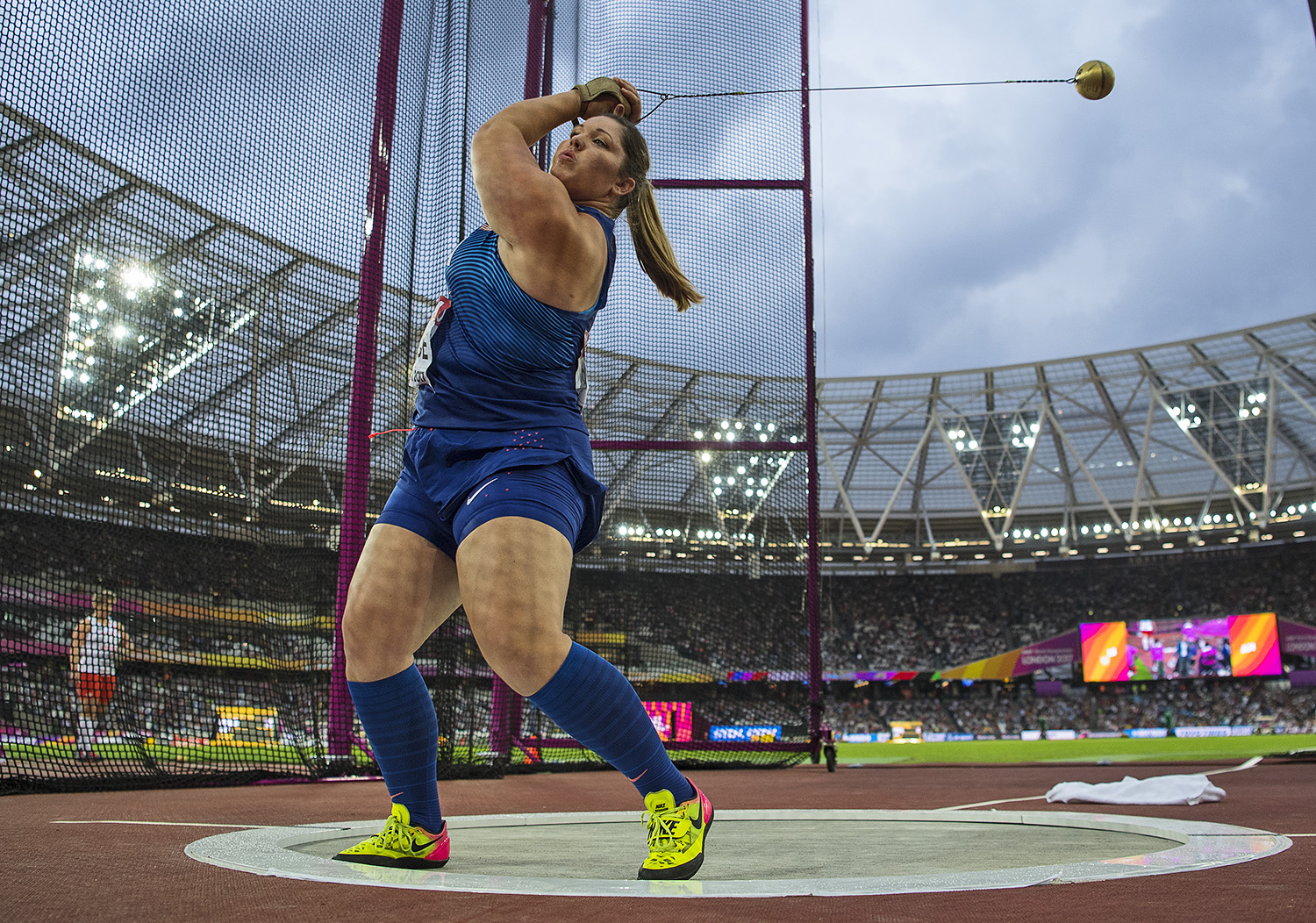Overview
The competitive performance of a thrower in track and field is an aggressive display of strength, power, and technique. The throws are complicated movements performed at high speed in limited spaces. From a training perspective, the hammer, weight throw, shot put, discus, and javelin are classified as the speed and power events. Although each event is unique, they share many qualities needed for success. Although physical condition and athleticism are both imperative, an athlete’s technical ability contributes significantly to overall performance. At the elite level of the sport, many believe that technique is the largest discriminating factor among athletes. Coaches of throwing athletes must help their athletes build and maintain strength while also developing refined techniques.
All skills in the throws events rely on an athlete having solid foundations in Long Term Athletic Development.
A basic movement vocabulary, physical literacy, and movement skills improves athletic success in the throws.
Shot Put
Shot-putters must develop a set of skills that at first may seem unnatural. They must learn posture and balance and feel comfortable pivoting on the ball of the foot. The arm strike in shot-putting is also unique to the event; no other sport requires a push from the front deltoid with the elbow at a 90-degree angle to the body.
Beginner Skills
- Sense of body position in space. (proprioception)
- Can effectively hold and support the shot put (two foot, one foot)
- Can hold the shot put with one hand under the neck or chin
- Can push the shot away from the body in a balanced position without the body falling backwards (standing throw) or (Scale) [Video]
- Can hop on the ground (backwards, forwards, two foot, one foot)
- Can balance body (two foot, one foot, eyes closed)
- Can stabilize the center of mass standing on 1 foot
- Can raise arms over the head
- Pivot 360 degrees (L,R)
- Throw a ball two-handed forward or backwards for height, distance
- Assume and hold power position
Intermediate Skills
- Demonstrate proper release mechanics without implement (wrist out, thumb down)
- Can remain balanced when explosively hopping up and down
- Can produce explosive force when hopping with two legs
- Can produce an explosive backwards hop on one leg
- Able to keep body posture in line during motion
- Has the ability to sequence or time body movements in a pre-determined order (psychomotor learning)
- Perform Russian Twist with 25lb weight
- Effectively navigates variable practice stimulus
- Displays game intelligence
- Block with non-throwing arm (shorten during rotation) while maintaining balance
- Ability to rotate hip creating a stretch reflex or hinged moment[Video]
- Understands the variables of parabolic flight of the shot put
Advanced Skills
- Produce high levels of explosive power (i.e. dunk basketball)
- Effectively perform exceptionally explosive movements
- Understands optimal velocity, height, and angle of release (variables parabolic flight)
- Perfection of the psychomotor capacity (smooth transfer of energy from start to release)
- Has developed maximal sport specific strength
- Effectively utilize the ground to apply and receive explosive forces
- Can employ either glide step or rotational technique [Video]
Discus
The discus throw requires athletes to exert high forces against the ground through a series of rhythmic movements. Because of the aerodynamic nature of the event, knowledge of the types of implements available is important. The discus is lighter in weight and travels faster and farther than the shot, but it is more difficult to control. Fully mastering the mechanics of the release is more difficult in the discus event than it is in the shot put event.
Beginner Skills
- Can correctly hold discus
- Can roll the discuss across the ground
- Can release the discuss so that it rolls off of the fingers on the front of the hand
- Can perform a hinged movement
- Can perform a twisting motion
- Can transition between static and dynamic movements
- Sense of body position in space. (proprioception)
- Can hop on the ground (two foot, one foot, forwards, backwards)
- Can balance the body (One foot, two foot, eyes closed)
- Can stabilize the center of mass standing on 1 foot
- Can raise arms over the head (shoulder mobility)
Intermediate Skills
- Well-developed power position
- Tall upright posture
- Can transfer weight on from one leg to the other with rapid acceleration
- Can squat double bodyweight
- Well developed timing of body movements
- Must understand how force is transferred through the body ( foot, shin, leg , hip, torso, chest, shoulder, biceps, triceps, wrist, fingers
- Well developed push turn, hip pop initiation [Video]
- Well-developed blocking action during the strike
- Can complete a 360 degree turn on one foot and land in a stable power position
- Well developed power position execution (transition from power position to release)
- Well developed core and hip strength
- Can control body limbs in space
- Explosive force to propel body across the circle and into the power position
Advanced Skills
- Can complete repetitive 360 degree turns on one leg with while remaining balanced
- Must possesses explosive power
- Master of balance
- Master of the blocking action
- Mastery of discus technique
- Master of optimal parabolic flight and how to manipulate wind movement to gain advantage
- Able to cope with open variables (competition environment)
- Master of timing and anticipation
Hammer Throw
The technical demands of the hammer throw make it very challenging for both the athlete and the coach, possibly second only to the pole vault. As with the other three throwing disciplines, the aim of the hammer throw is to project the implement as far as possible without committing a foul. Athletes commence a throw by performing preliminary winds, or swings, in which they swing the hammer overhead in a circular arc while facing the rear of the circle. They accelerate the hammer to the point of release by performing turns across the throwing circle.
Beginner Skills
- Sense of body position in space. (proprioception)
- Can hop on the ground (backwards, forwards, two foot, one foot)
- Can balance body (two foot, one foot, eyes closed)
- Can stabilize the center of mass standing on 1 foot
- Can raise arms over the head
- Pivot 360 degrees (L,R)
- Throw a med ball two-handed forward, backwards, rotational for height, distance
- Assume and hold power position
- Rotationally throw non-hammer object (3-4’ length; bat, broom, etc…)
- Perform turns without the hammer (turn on left heel, right ball of foot)
- Complete rotational throws with extended arms (non-hammer object)
Intermediate Skills
Advanced Skills
Javelin
Unlike other throwing events, the javelin allows the competitor to build speed over a considerable distance. In addition to core and upper-body strength, javelin throwers benefit from the agility and athleticism typically associated with running and jumping events. Successful javelin throwers often share more physical characteristics with sprinters and jumpers than with athletes in the other throwing events. However, javelin throwers still require the power associated with larger and heavier athletes. Because javelin throwing can be stressful on the shoulder and arm, proper technique is particularly important.
Beginner Skills
- Able to run in a straight line
- Able to run with one hip leading
- Able to cross step
- Able to run with a steady rhythm
- Demonstrate full range of shoulder mobility
- Extend arm and wrist with pronation
- Throw ball with a stepping motion
- Throw ball from a running motion
- Able to grip the javelin
Intermediate Skills
Advanced Skills
- Explosive run up speed to full delivery
- Explosive accelerated crossovers
- Explosive hip drive
- Transfer of weight at high speed during blocking
- Extremely flexible arm
- High Core Strength
- Master blocking leg
- Optimal stretch reflex activation proximal to distal
- Master at throwing through the point of the javelin
- Understand aerodynamics mastery
- Parabolic flight release







